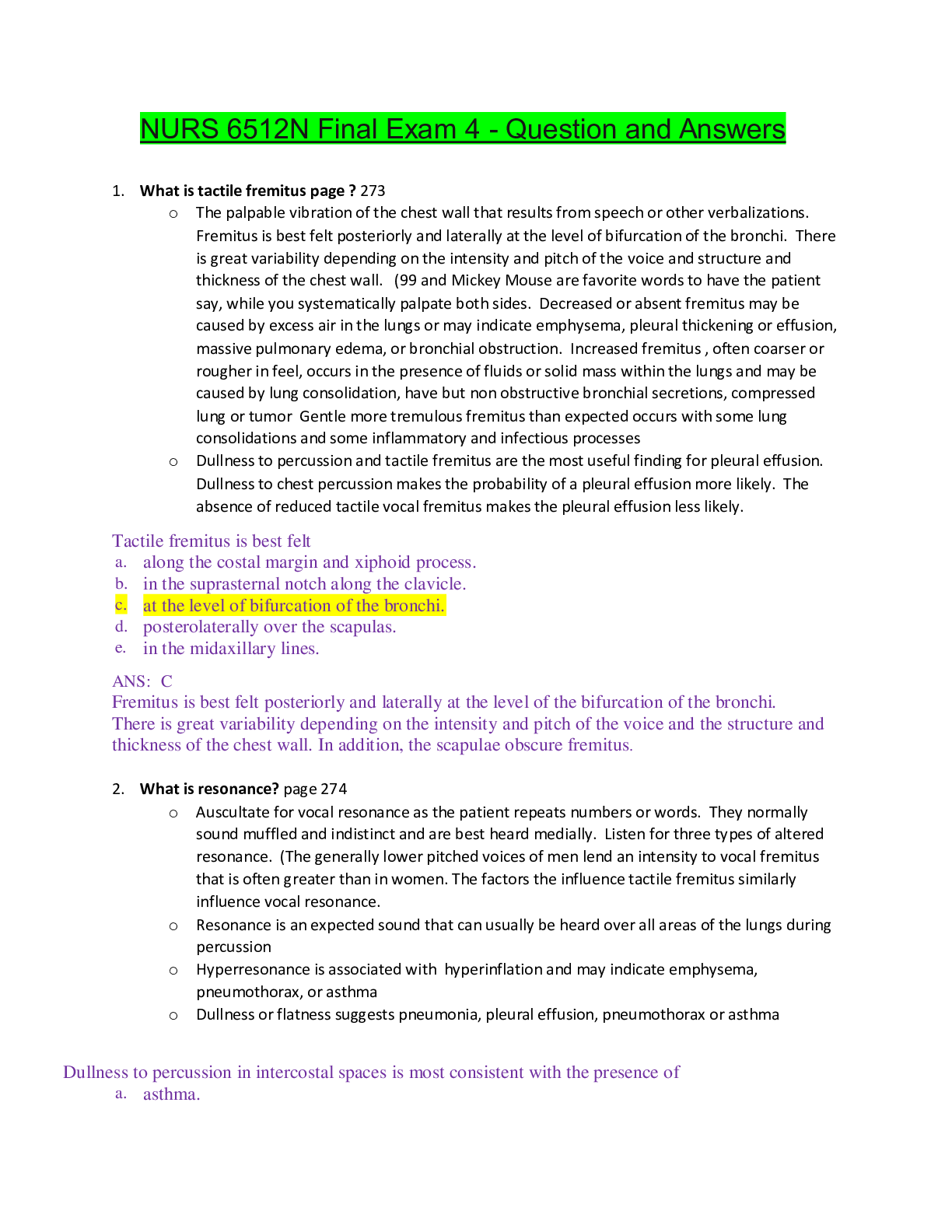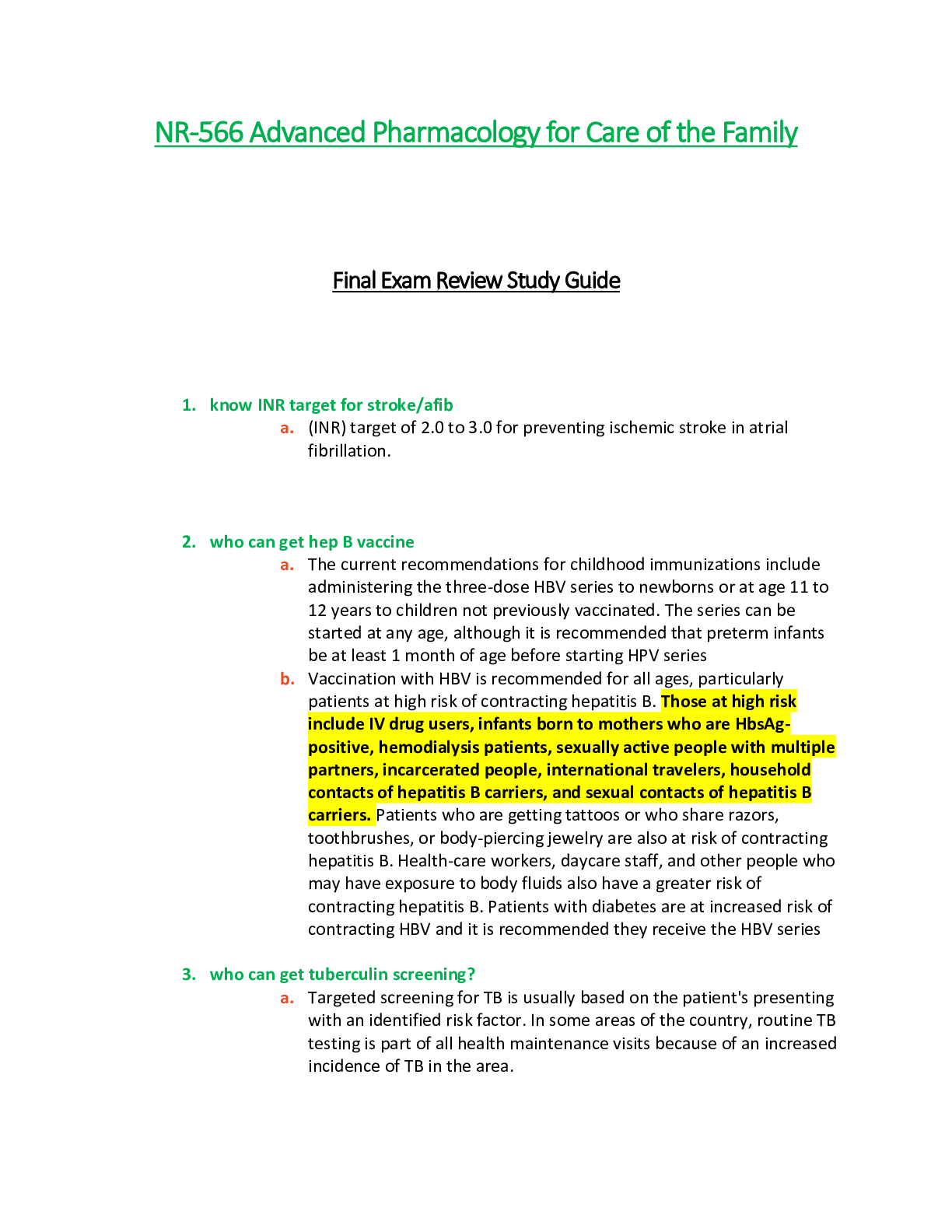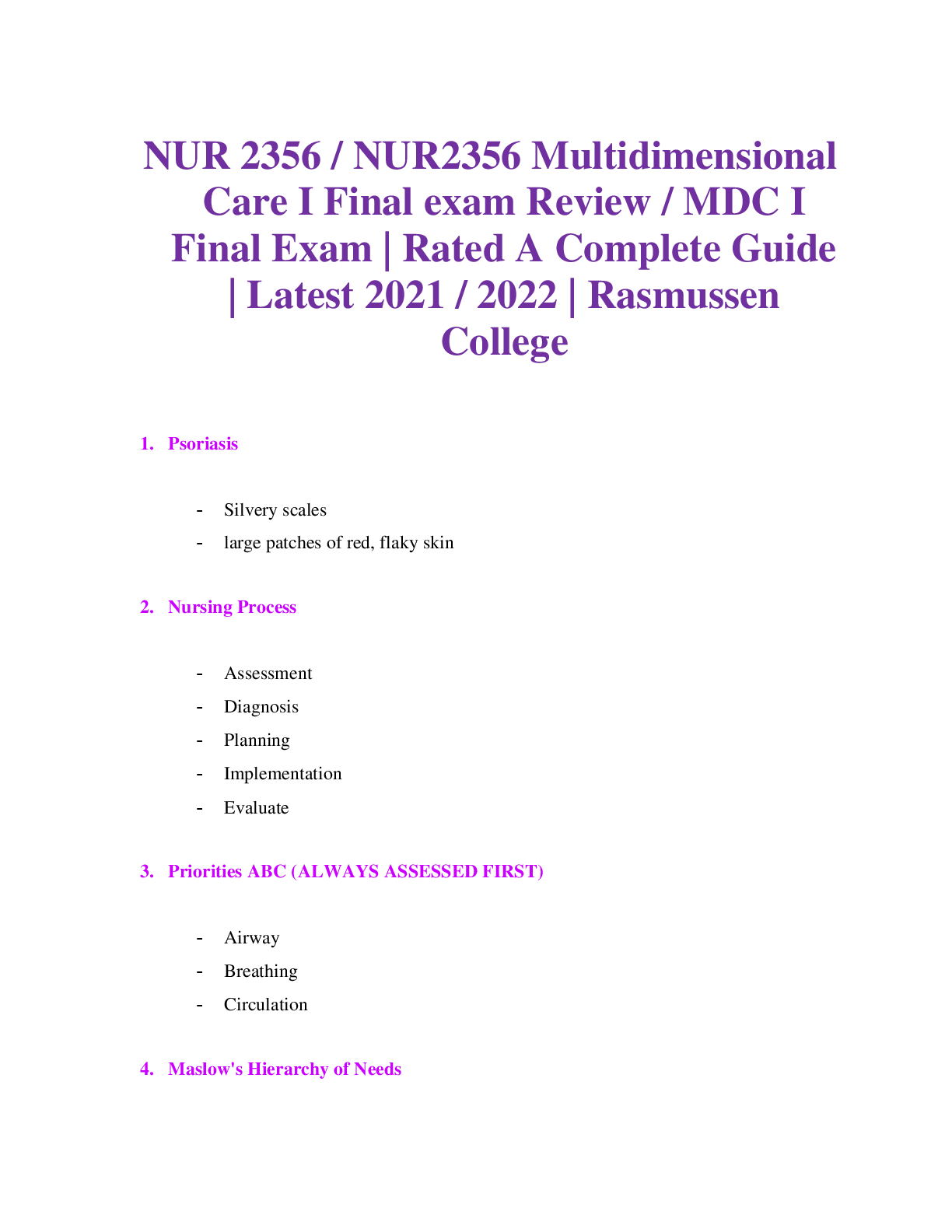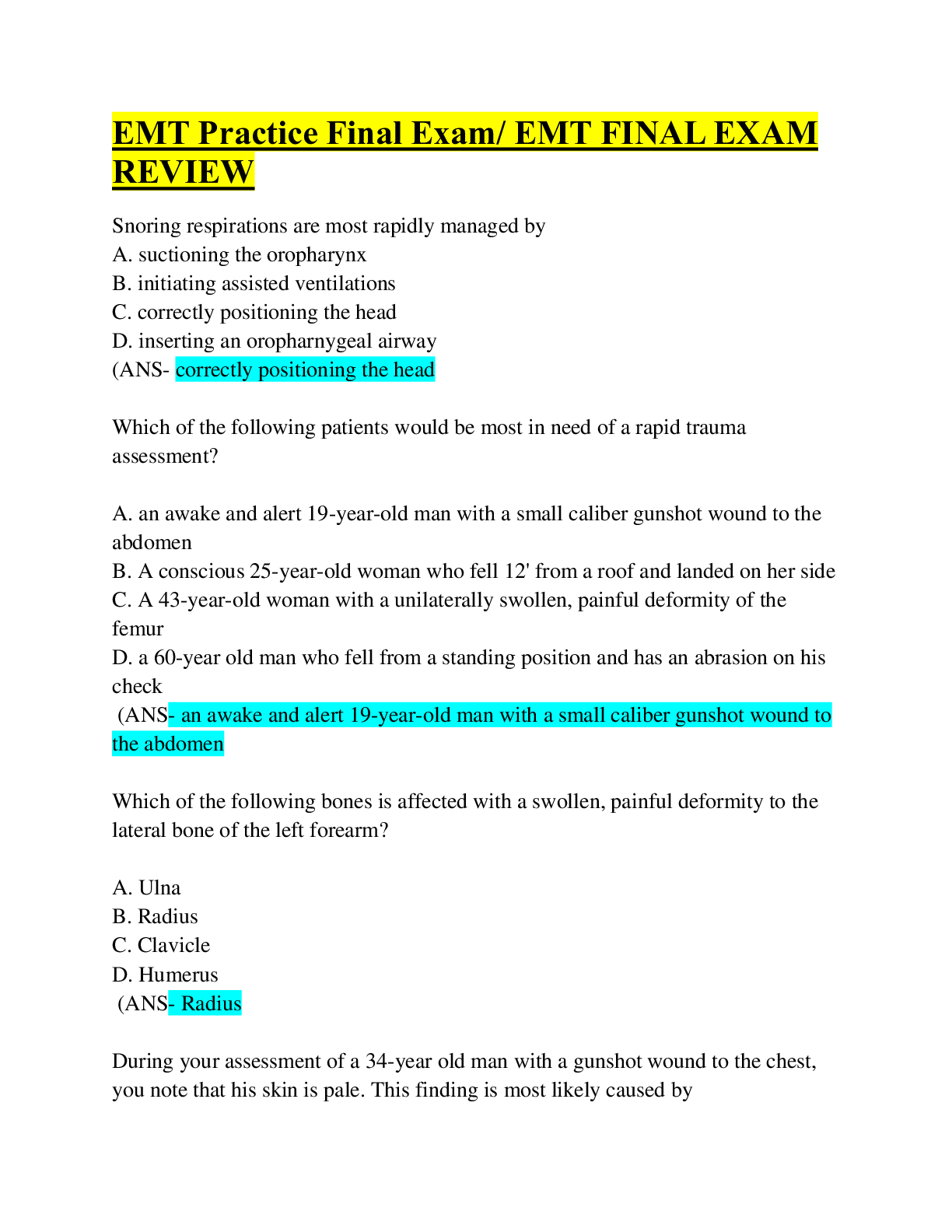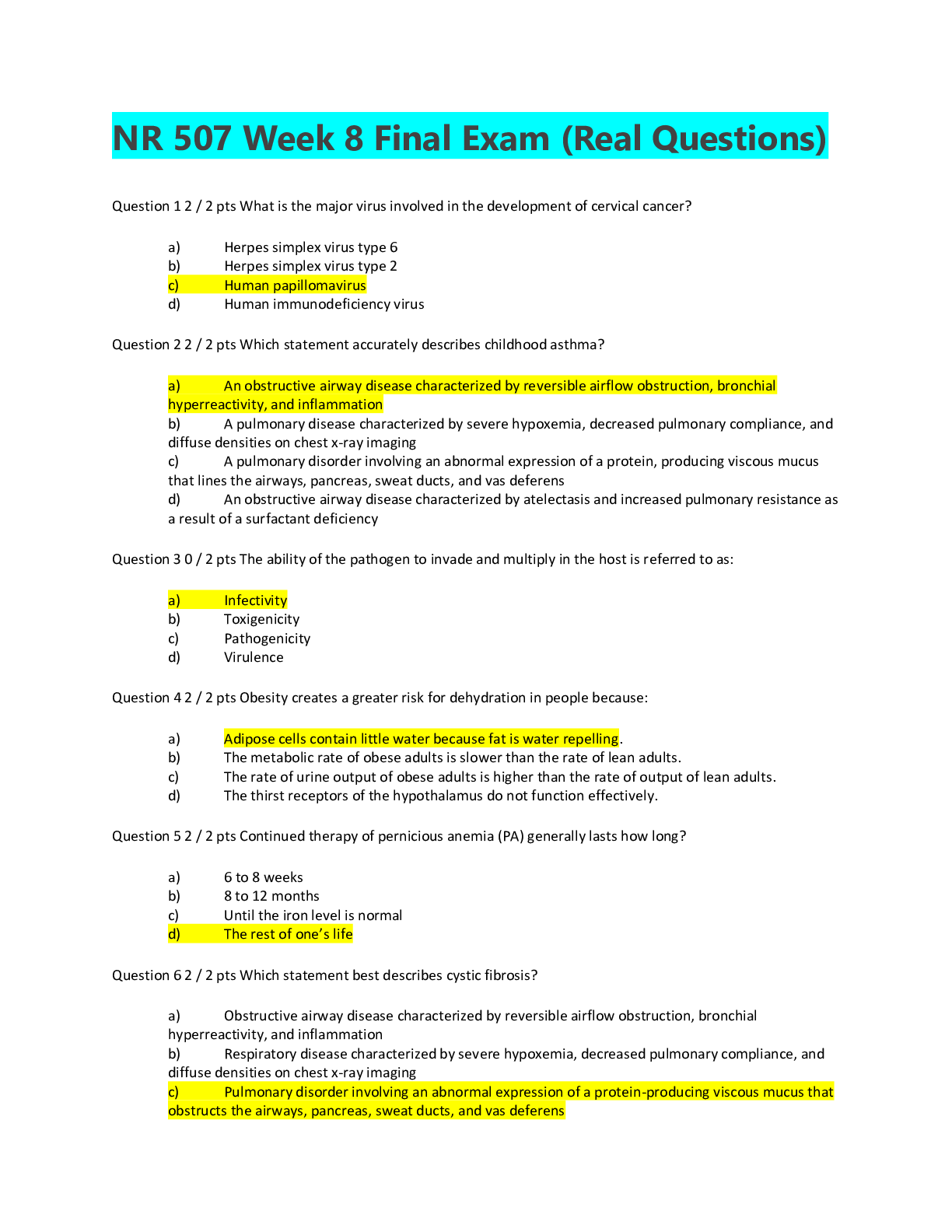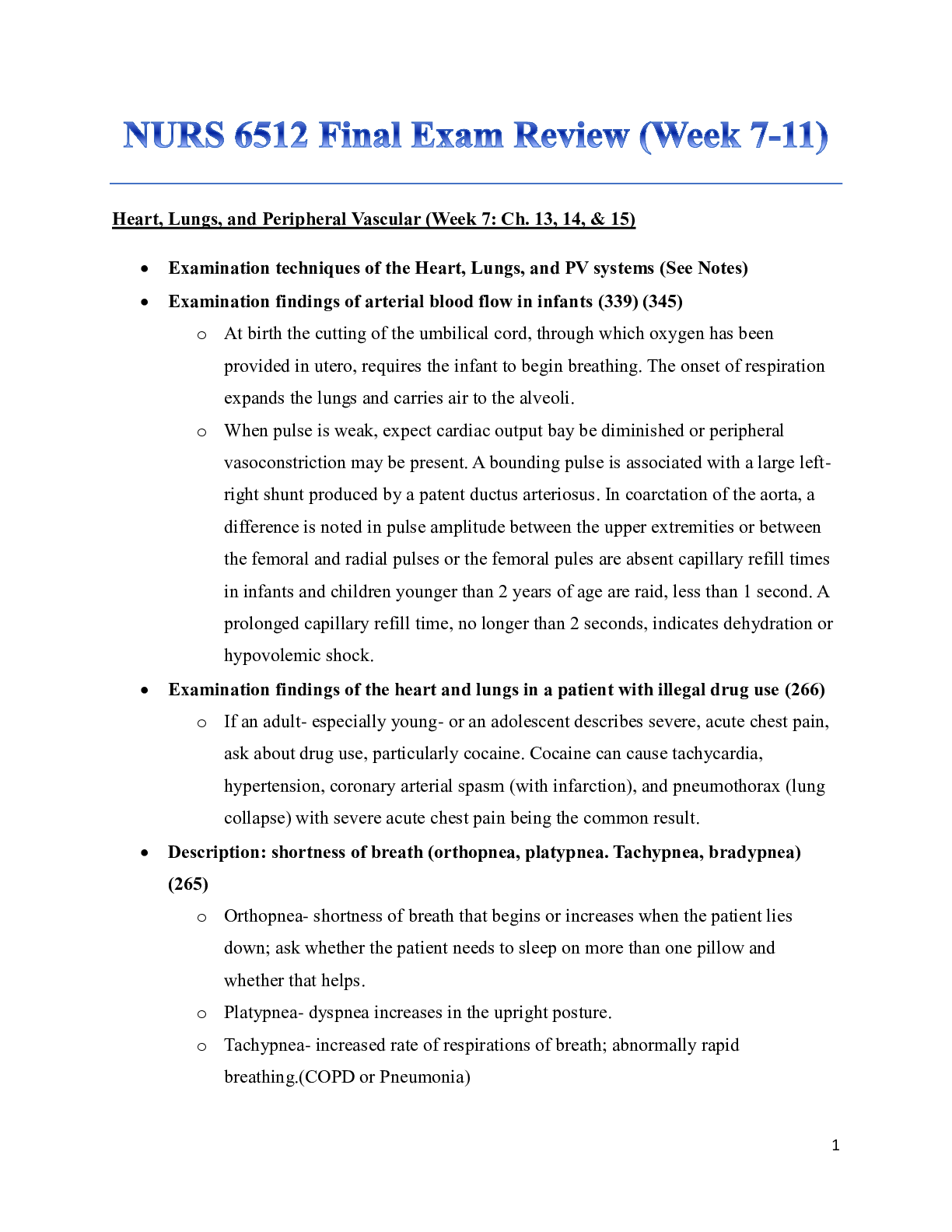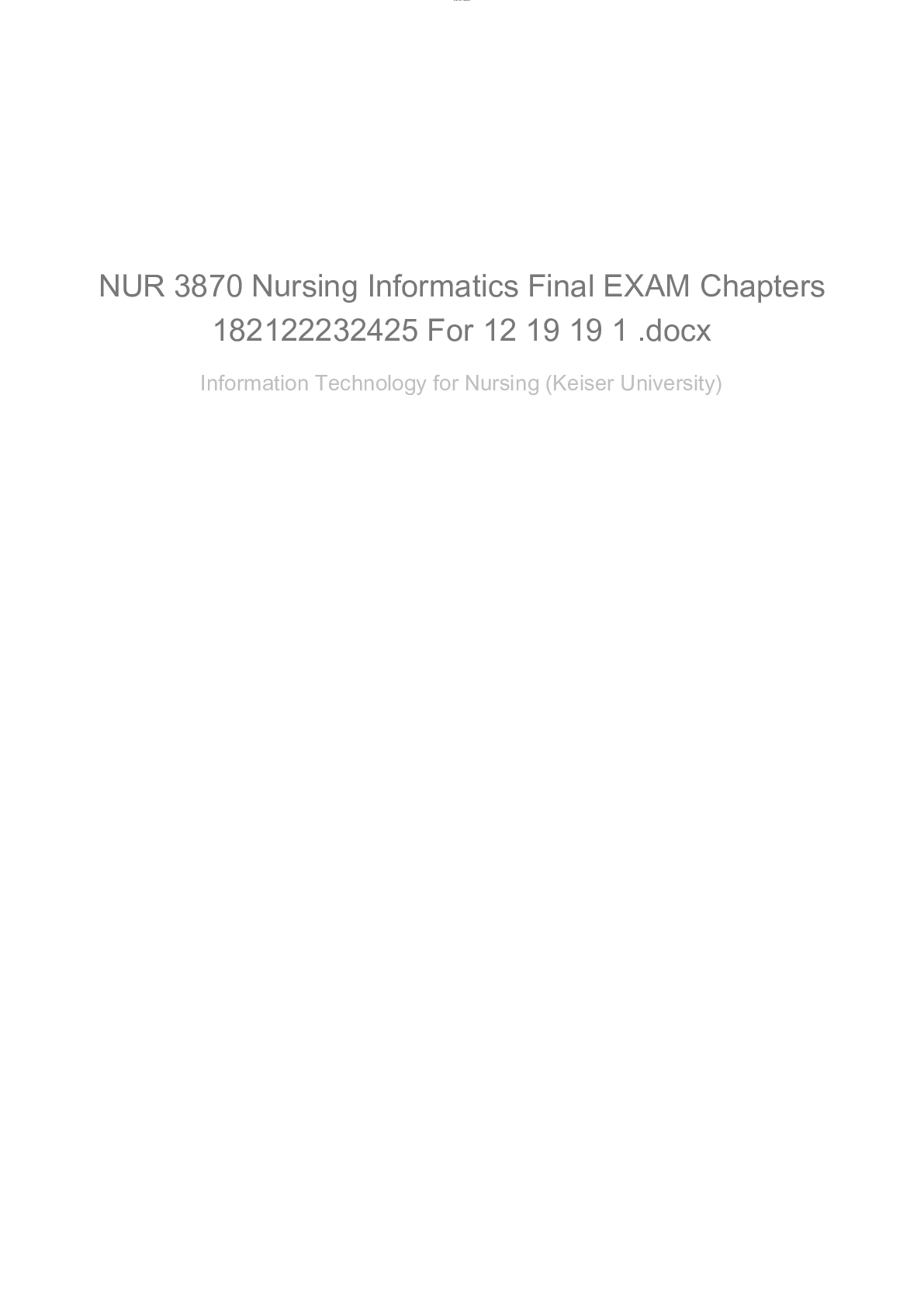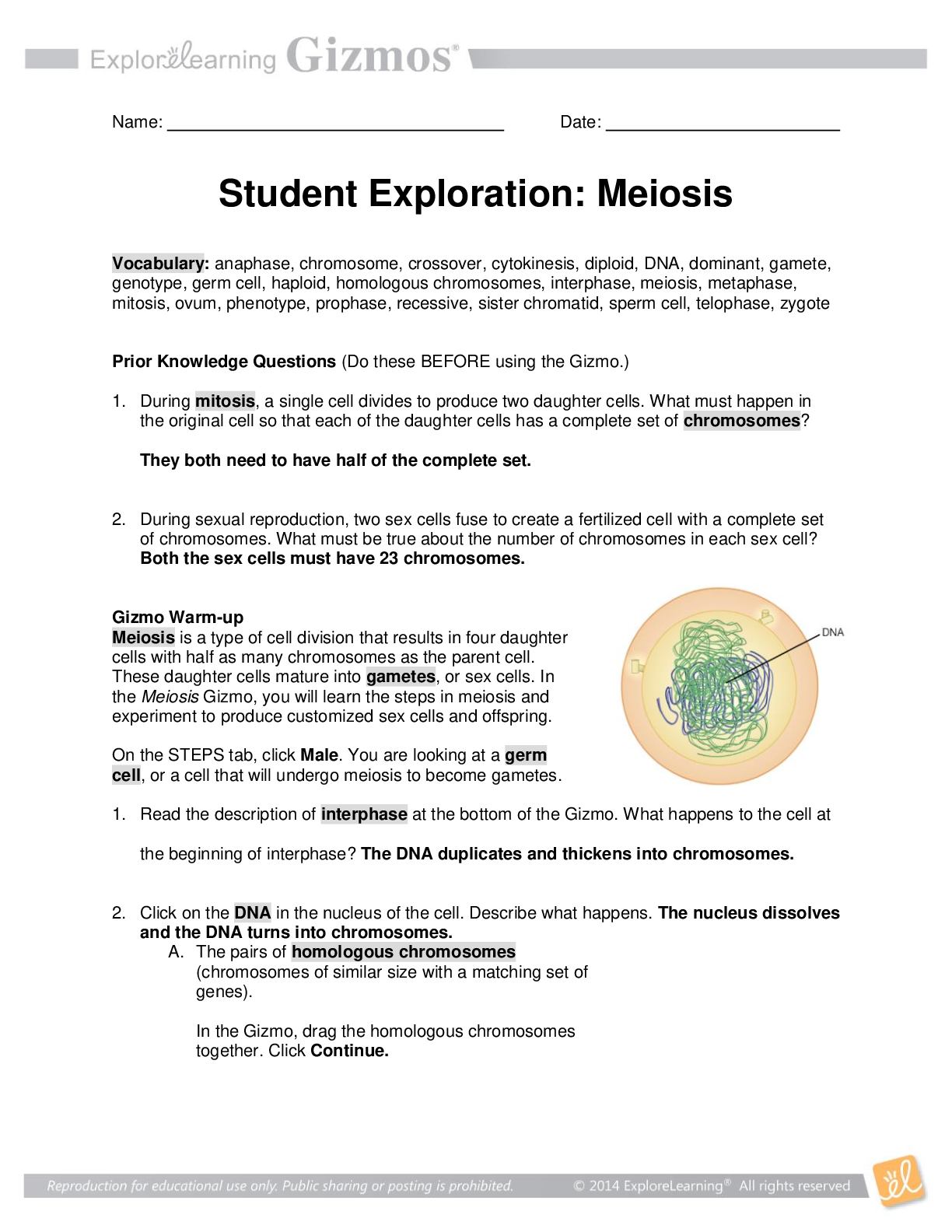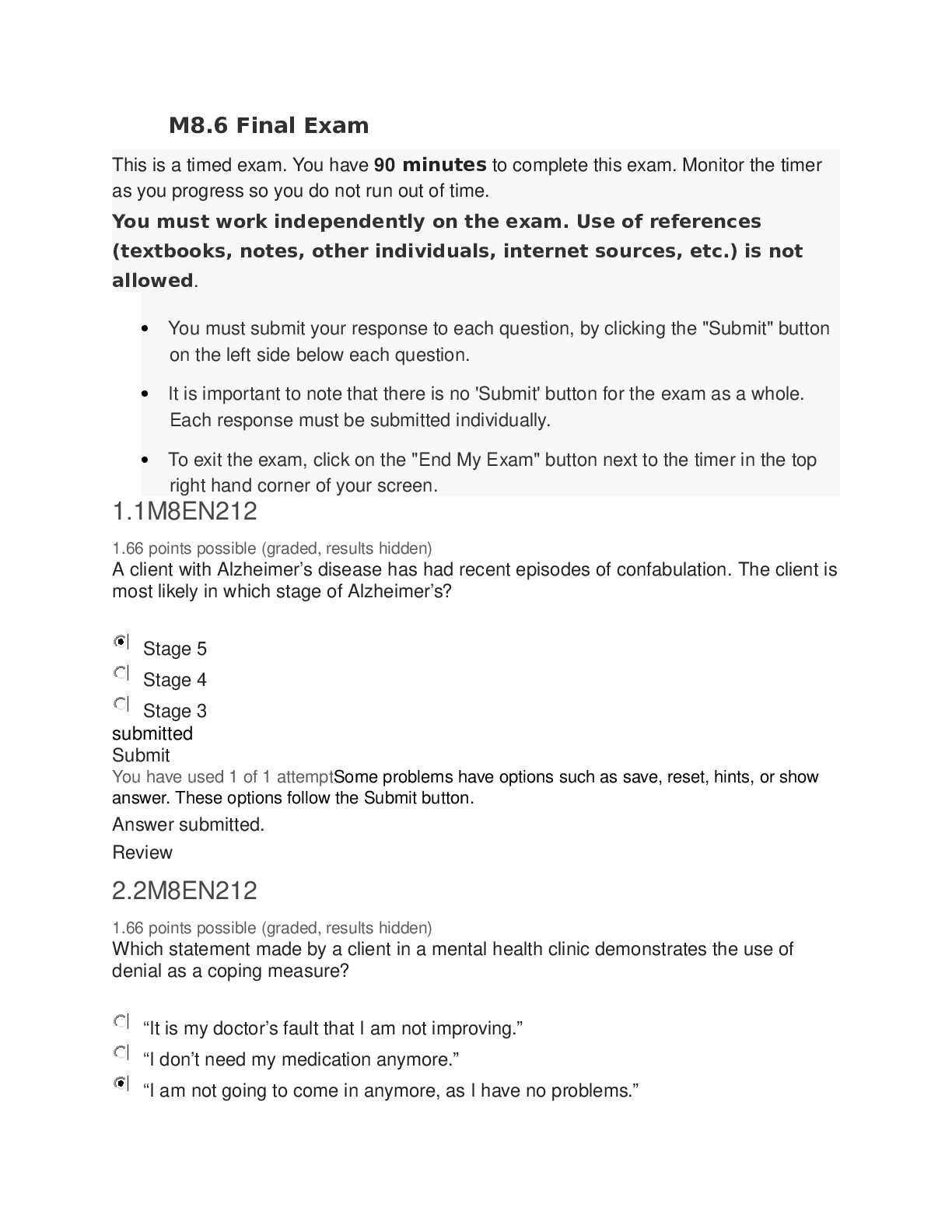*NURSING > Final Exam Review > final exam NURS 1385 (All)
final exam NURS 1385
Document Content and Description Below
final exam NURS 1385 Chapter 10: Pain Test Bank MULTIPLE CHOICE 1. A 45-year-old woman has breast cancer that has spread to her liver and spine. She has been taking oxycodone (Percodan) ... and amitriptyline (Elavil) for pain control at home but now has constant severe pain and is hospitalized for pain control and development of a pain-management program. During assessment of the client, what information related to her pain is most important for the nurse to obtain initially? Pain is a complex experience involving physiological, sensory (i.e., the perception of pain by the individual that addresses the pain location, intensity, pattern, and quality), affective, behavioural, and cognitive dimensions; therefore, the nurse needs to assess the pattern, area, nature, and intensity of the pain immediately. 2. The physician plans to titrate narcotic analgesic to provide pain relief for a client with surgical pain. What does the nurse’s role in analgesic titration include? The goal of titration is to use the smallest dosage of analgesic that provides effective pain control with the fewest side effects. 3. It is determined that a step 3 drug as proposed by the World Health Organization (WHO) is necessary for a client whose cancer pain is unrelieved by step 2 drugs. Which is an appropriate drug and route for this client? 4. A client using gabapentin (Neurontin) and ibuprofen (Motrin, Advil) for chronic neuropathic pain of diabetic neuropathy has moderate, persistent pain. The physician plans to implement step 2 of the WHO analgesic ladder. What should the nurse anticipate that the client’s drug protocol will include? 5. The physician tells a client to use ibuprofen (Motrin, Advil) to relieve the pain after treating a laceration on the client’s forearm from a dog bite. The client tells the nurse that he does not think ibuprofen will control his pain. The nurse’s response is based on the knowledge that ibuprofen interferes with the pain by decreasing what process? 6. A postoperative client who has undergone extensive bowel surgery moves as little as possible and does not use his incentive spirometer unless specifically reminded. He rates his pain severity as an 8 on a 10-point scale but tells the nurse that he can “tough it out.” To encourage the client to use pain medication, what should the nurse explain about the effects of withholding or delaying analgesics? 7. A client with a kidney stone in her right ureter has pain in her right flank area and also complains of pain in her right inner thigh. She asks the nurse whether something is wrong with her leg. In responding to the question, on what knowledge does the nurse base the client’s understanding of pain? 8. Following an automobile accident, a client is brought to the emergency department with multiple fractures and lacerations. The client is dazed but oriented and denies severe pain. What is the client’s decreased pain perception most likely related to? 9. Imipramine (Tofranil), a tricyclic antidepressant, is being administered to a client with chronic cancer pain. What does the nurse recognize as the expected outcome of administration of this drug? 10. A client with chronic abdominal pain has learned to control the pain with the use of imagery and hypnosis. What does the nurse recognize about how these cognitive strategies work? 11. When administering mixed opioid agonist–antagonists, such as pentazocine (Talwin), what does the nurse recognize is an advantage of these drugs in comparison with opioid agonists? 12. An 86-year-old man has severe degenerative arthritis in his hips. In planning care for the client, what does the nurse recognize about chronic pain in an older adult? 13. In developing a concept of pain to use in working with clients experiencing pain, what does the nurse acknowledge about pain? 14. To obtain the most complete assessment data about a client’s chronic pain pattern, what should the nurse ask the client? 15. Morphine 10 mg IV every 4 to 6 hours PRN is ordered for a client with a pancreatic tumour who has a history of alcoholism. After 3 days of receiving the morphine every 6 hours, the client tells the nurse that the medication is needed more frequently to control the pain. In responding to the client’s request, what does the nurse recognize? 16. A client with extensive second-degree burns on his legs and trunk is using patient-controlled analgesia (PCA) with IV morphine to be delivered at 1 mg every 10 minutes to control his pain. Several times during the night, he awakens in severe pain, and it takes more than an hour to regain pain relief. What is the most appropriate nursing action at this time? 17. When caring for a client who is receiving epidural fentanyl, what common side effects should the nurse monitor the client for? 18. A client receiving PRN intermittent IV administration of opiates following gastric surgery watches her favourite television programs every morning. She does not request more pain medication during this time and, when questioned by the nurse, states that she does not need more medication. Which of the following explanations best describes this client’s response to the pain relief? 19. A client in the terminal stage of cancer is cared for by her family at home with the assistance of visiting hospice nurses. She is in continuous malignant pain, and the physician has left orders to administer morphine at a rate to control her pain. When the nurse visits the client, she is awake but moaning with severe pain and asks for an increase in her morphine dosage. Her respirations are 10 per minute. What is the most appropriate nursing action at this time? 1. The nurse is precepting a student nurse and explains that perioperative nursing care occurs 2. The nurse is caring for a patient who is scheduled to undergo a surgical procedure. The nurse is completing an assessment and reviews the patient's laboratory tests and allergies. In which perioperative nursing phase would this work be completed? 3. The nurse is caring for a patient in the postanesthesia care unit. The patient has developed profuse bleeding from the surgical site, and the surgeon has determined the need to return to the operative area. This procedure would be classified as 4. The nurse is caring for a patient in preadmission testing. The patient has been assigned a physical status classification by the American Society of Anesthesiologist of P3. Which of the following assessments would support this classification? 5. The patient has presented to the ambulatory surgery center to have a colonoscopy. The patient is scheduled to receive moderate sedation (conscious sedation) during the procedure. Moderate sedation is used routinely for procedures that require ( 6. The nurse is caring for a patient in the postanesthesia care unit who has undergone a left total knee arthroplasty. The anesthesia provider has indicated that the patient received a left femoral peripheral nerve block. Which assessment would be an expected finding for a patient with this type of regional block? 7. The nurse is preparing a patient for surgery. Aims of assessment before surgery include 8. The nurse is completing a medication history for the surgical patient in preadmission testing. Which of the following medications should the nurse instruct the patient to hold in preparation for surgery? 9. The nurse is caring for a potential surgical patient in the preadmission testing unit. The medication history indicates that the patient is currently taking warfarin (Coumadin). Which of the following actions should the nurse take? 10. The nurse is encouraging the postoperative patient to utilize diaphragmatic breathing. Reasons for this intervention include 11. The nurse is caring for a postoperative patient on the medical-surgical floor. To prevent venous stasis and the formation of thrombus after general anesthesia, the nurse encourages 12. The nurse is caring for a preoperative patient. The nurse teaches the principles and demonstrates leg exercises for the patient. The patient is unable to perform leg exercises correctly. What is the nurse's best next step? 13. Which nursing assessment would indicate that the patient is performing diaphragmatic breathing correctly? 14. The nurse is caring for a postoperative patient with an abdominal incision. A pillow is used during coughing to provide 15. The nurse is encouraging a reluctant postoperative patient to deep breathe and cough. What explanation can the nurse provide that may encourage the patient to cough more effectively? 16. The nurse and the nursing assistant are assisting a postoperative patient to turn in the bed. To assist in minimizing discomfort, which instruction should the nurse provide to the patient? 17. The nurse is preparing to assist the patient in using the incentive spirometer. Which nursing intervention should the nurse provide first? 18. The nurse and the nursing assistant are caring for a group of postoperative patients who need turning, coughing, deep breathing, incentive spirometer, and leg exercises. The nurse directs the nursing assistant to 19. The nurse is providing preoperative teaching for the ambulatory surgery patient who will be having a cyst removed from the right arm. Which would be the best explanation for diet progression after surgery? 20. The nurse explains the pain relief measures available after surgery during preoperative teaching for a surgical patient. Which of the following comments from the patient indicates the need for additional education on this topic? 21. The nurse is making a preoperative education appointment with a patient. The patient asks if he should bring family with him to the appointment. What is the best response by the nurse? 22. The nurse is reviewing the surgical consent with the patient during preoperative education. The patient indicates that he does not understand what procedure will be completed. What is the nurse's best next step? 23. During preoperative assessment for a 7:30 case, the patient indicates to the nurse that he had a cup of coffee this morning. The nurse reports this information to the anesthesia provider anticipating 24. The nurse has administered an anxiolytic as a preoperative medication to the patient going to surgery. Which of the following is the best next step? 25. The nurse has completed a preoperative assessment for a patient going to surgery and gathers assessment data. Of the following, which would be the most important next step? 26. The nurse is preparing a patient for a surgical procedure on the right great toe. Which of the following actions would be most important to include in this patient's preparation? 27. The nurse is caring for a patient intraoperatively. Primary roles of the circulating nurse include 28. The nurse is caring for a patient in the preoperative holding area of an ambulatory surgery center. Which nursing action would be most appropriate for this area? 29. The nurse is caring for a patient in the operating suite. Which of the following outcomes would be most appropriate for this patient? 30. The nurse is concerned about the skin integrity of the patient in the intraoperative phase of surgery. Which of the following actions helps to minimize skin breakdown? 31. The nurse is caring for a postoperative patient with a history of obstructive sleep apnea. The nurse monitors for which of the following? 32. The nurse is caring for a patient in the operating suite who is experiencing hypercarbia, tachypnea, tachycardia, premature ventricular contractions, and muscle rigidity. The nurse suspects that this patient may be experiencing 33. The nurse is caring for a postoperative patient who has had a carpel tunnel repair. The patient has a temperature of 97° F and is shivering. Which of the following is the best reason for this condition? 34. The nurse is monitoring a patient in the postanesthesia care unit (PACU) for postoperative fluid and electrolyte imbalance. Which of the following actions would be most appropriate for this patient? .) 35. The nurse is caring for a patient in the postanesthesia care unit. The patient asks for a bedpan and states to the nurse, "I feel like I need to go to the bathroom, but I can't." Which of the following nursing interventions would be most appropriate? 36. The postanesthesia care unit (PACU) nurse transports the inpatient surgical patient to the medical-surgical floor. Before leaving the floor, the medical-surgical nurse obtains a complete set of vital signs. What is the rationale for this nursing action? 37. The nurse is caring for a patient who will undergo a coronary artery bypass graft procedure. What level of care will the patient require immediately post procedure? 38. The ambulatory surgical nurse calls to check on the patient at home the morning after surgery. The patient is reporting continued nausea and vomiting. Which of the following discharge education points should be reviewed with the patient? 39. The nurse is precepting a new nurse in the perioperative area. The nurse explains that perioperative nursing is based on certain principles and includes (Select all that apply.) 40. The nurse is caring for an ambulatory surgery patient. To be discharged home, what criteria must the patient meet? (Select all that apply.) 41. The nurse is caring for a postoperative patient with an incision. Which of the following nursing interventions have been found to decrease wound infections? (Select all that apply.) 42. The nurse is preparing for a patient who will be going to surgery. The nurse screens for risk factors that can increase a person's risks in surgery. What risk factors are included in the nurse's screening? (Select all that apply.) 43. The nurse is providing preoperative education and reviews with the patient what it will be like to be in the surgical environment. What points should the nurse include? (Select all that apply.) 44. The nurse is using a preoperative checklist to assist in preparing a patient on the day of surgery. What will the checklist include? (Select all that apply.) a. Vital signs 45. The nurse is caring for a patient in the operating suite. The nurse assists in positioning the patient to (Select all that apply.) 1. Obesity places patients at an increased surgical risk because of which of the following factors? (Select all that apply.) 2.The primary reason that family members should be included when the nurse teaches the patient preoperative exercises is so they can: 3.In the postanesthesia care unit (PACU) the nurse notes that the patient is having difficulty breathing and suspects an upper airway obstruction. The nurse would first: ................................................................................................continued....................................................................................................... [Show More]
Last updated: 1 year ago
Preview 1 out of 253 pages
Instant download
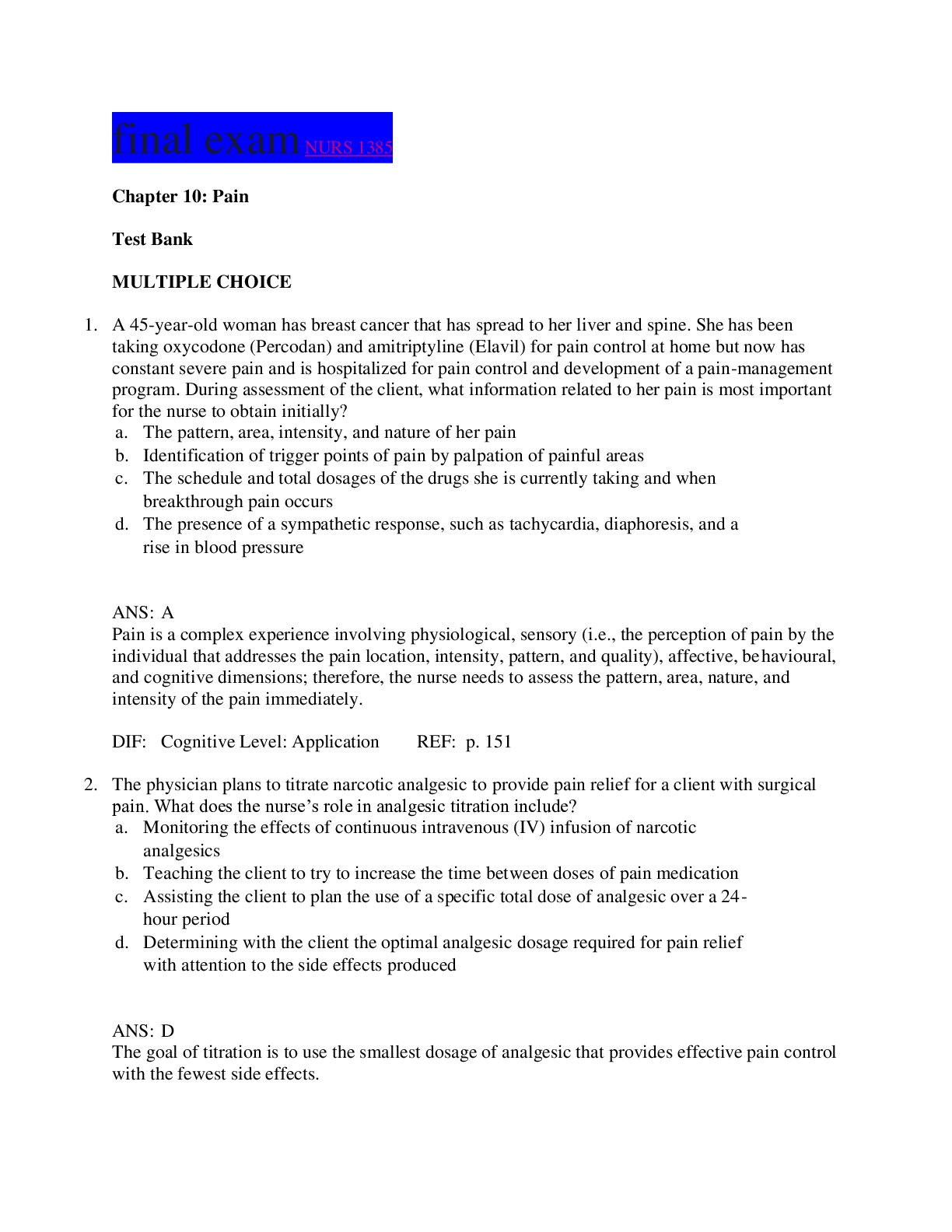
Instant download
Reviews( 0 )
Document information
Connected school, study & course
About the document
Uploaded On
Jan 10, 2021
Number of pages
253
Written in
Additional information
This document has been written for:
Uploaded
Jan 10, 2021
Downloads
0
Views
60

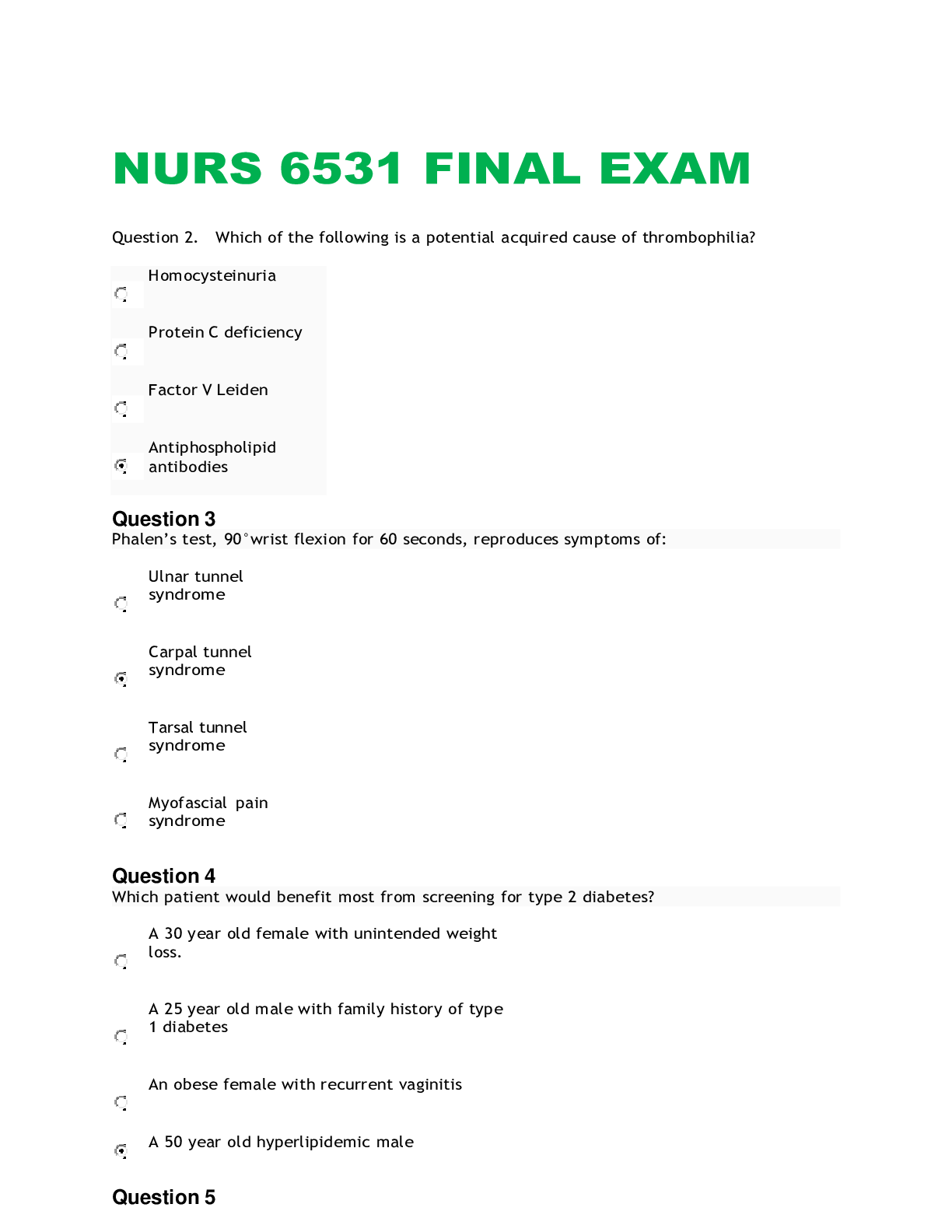


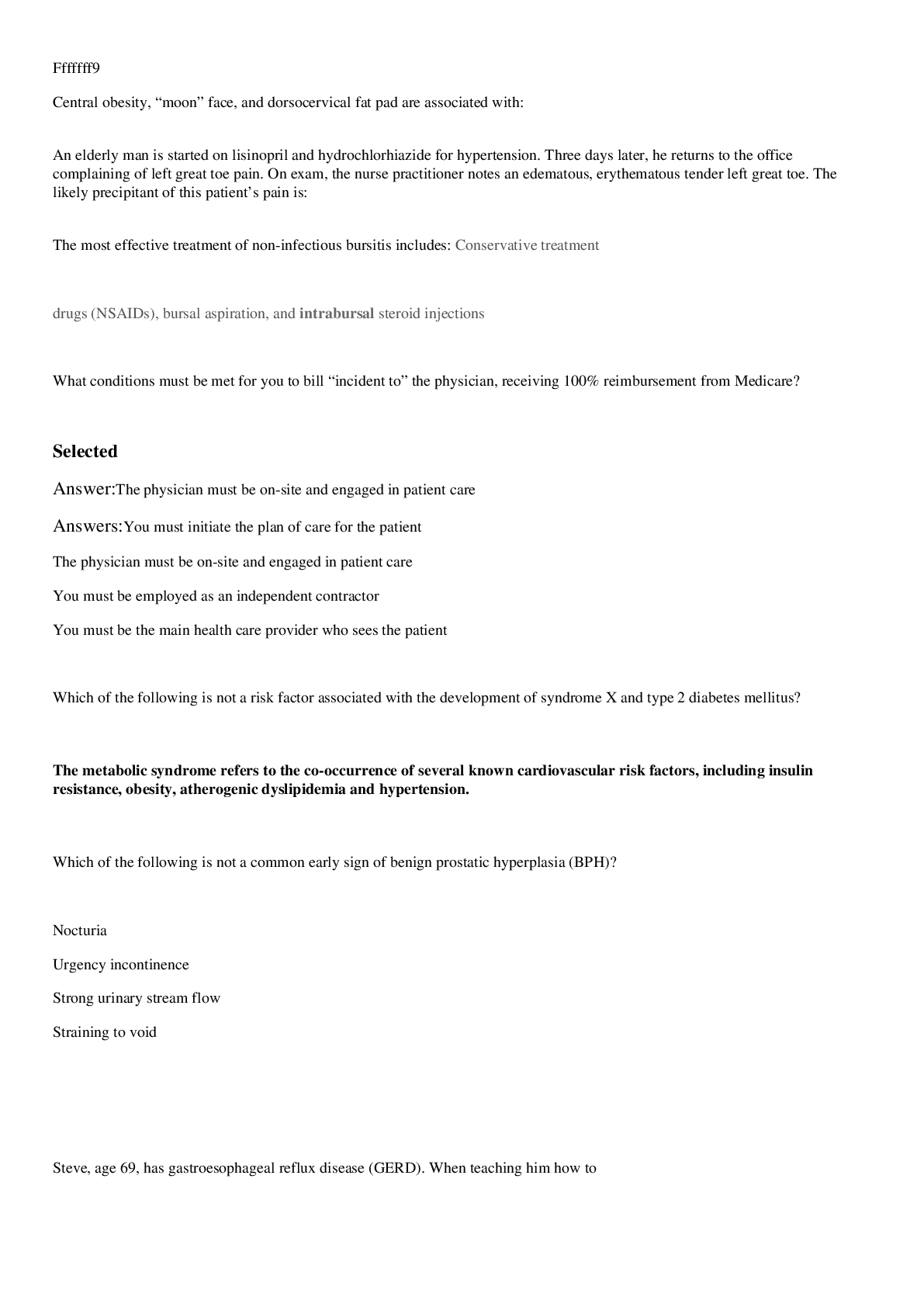


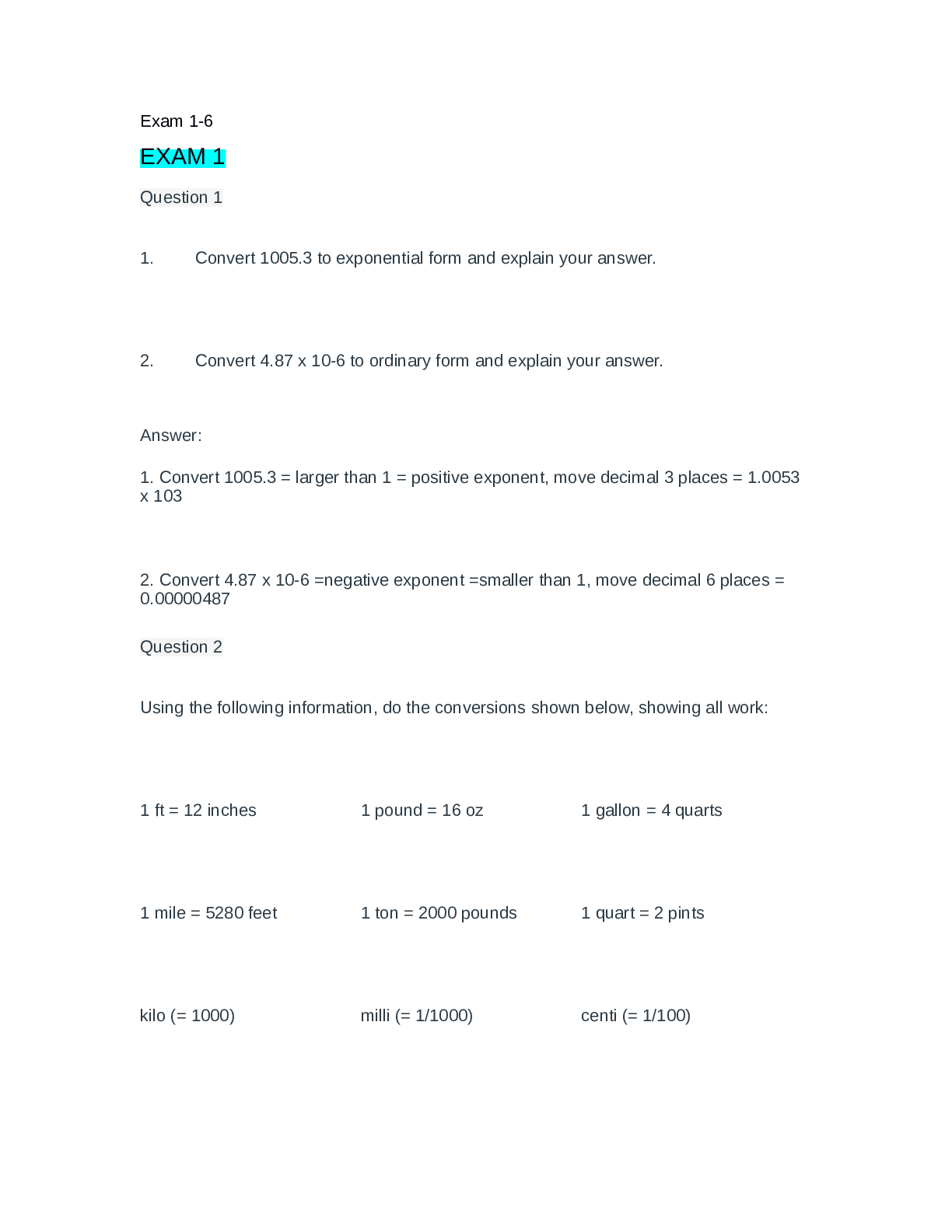
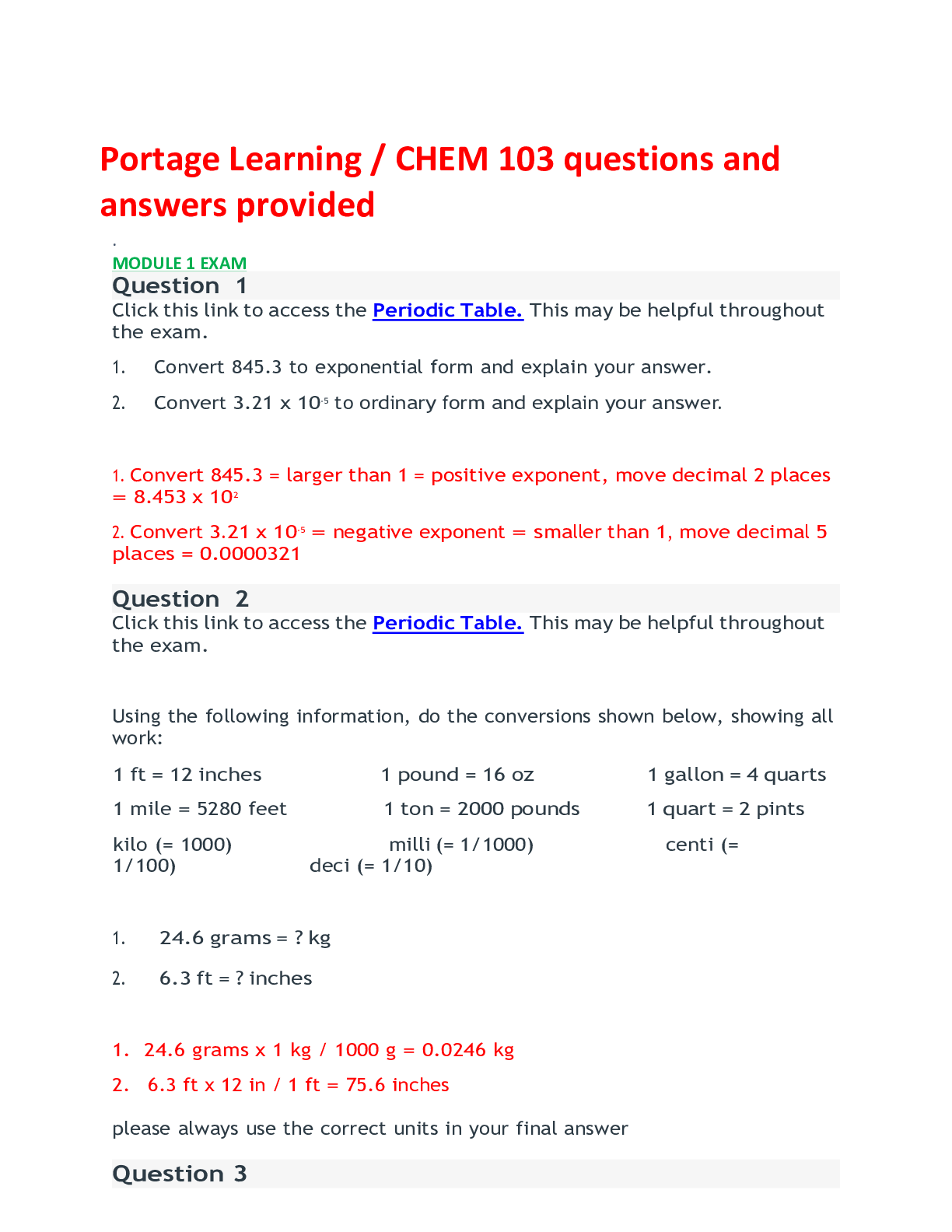
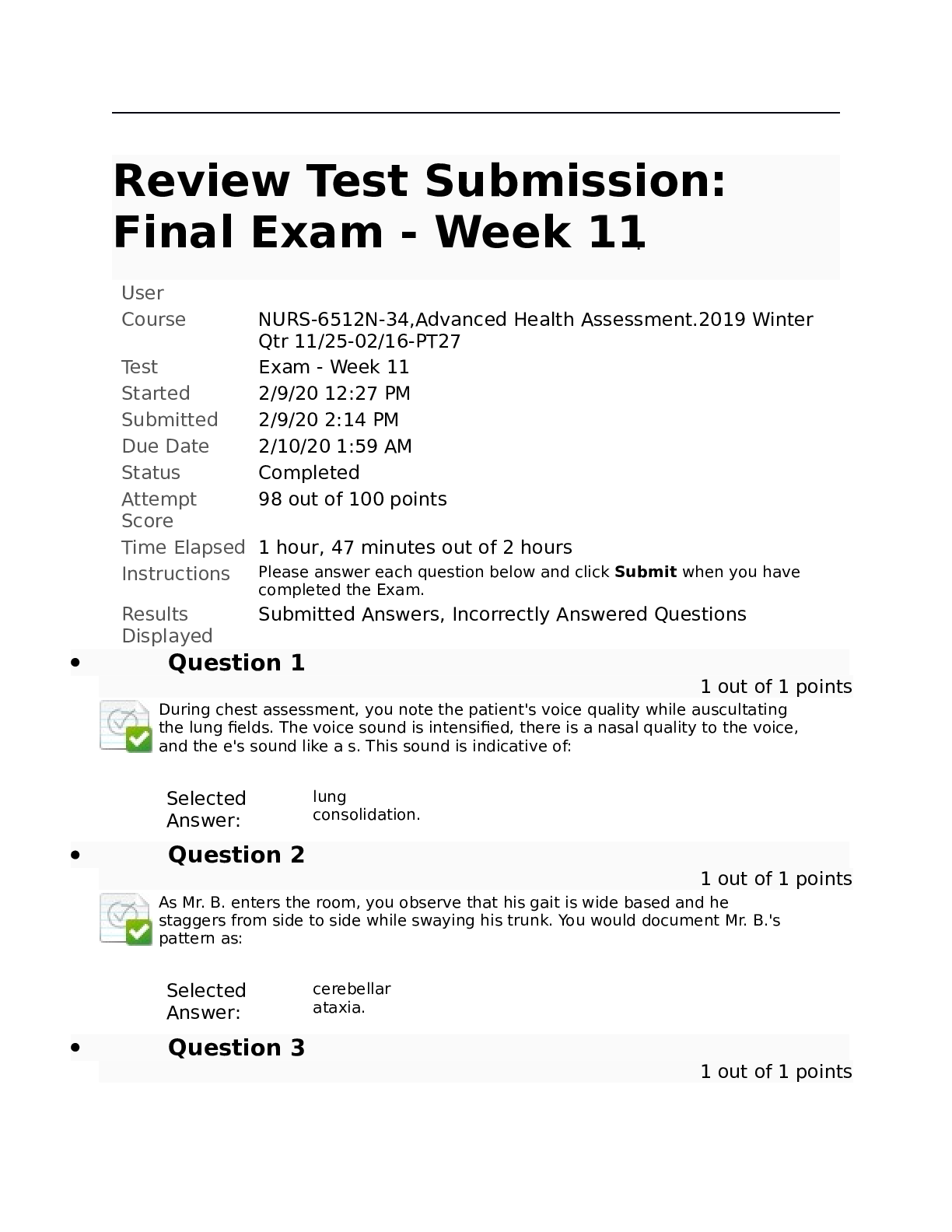
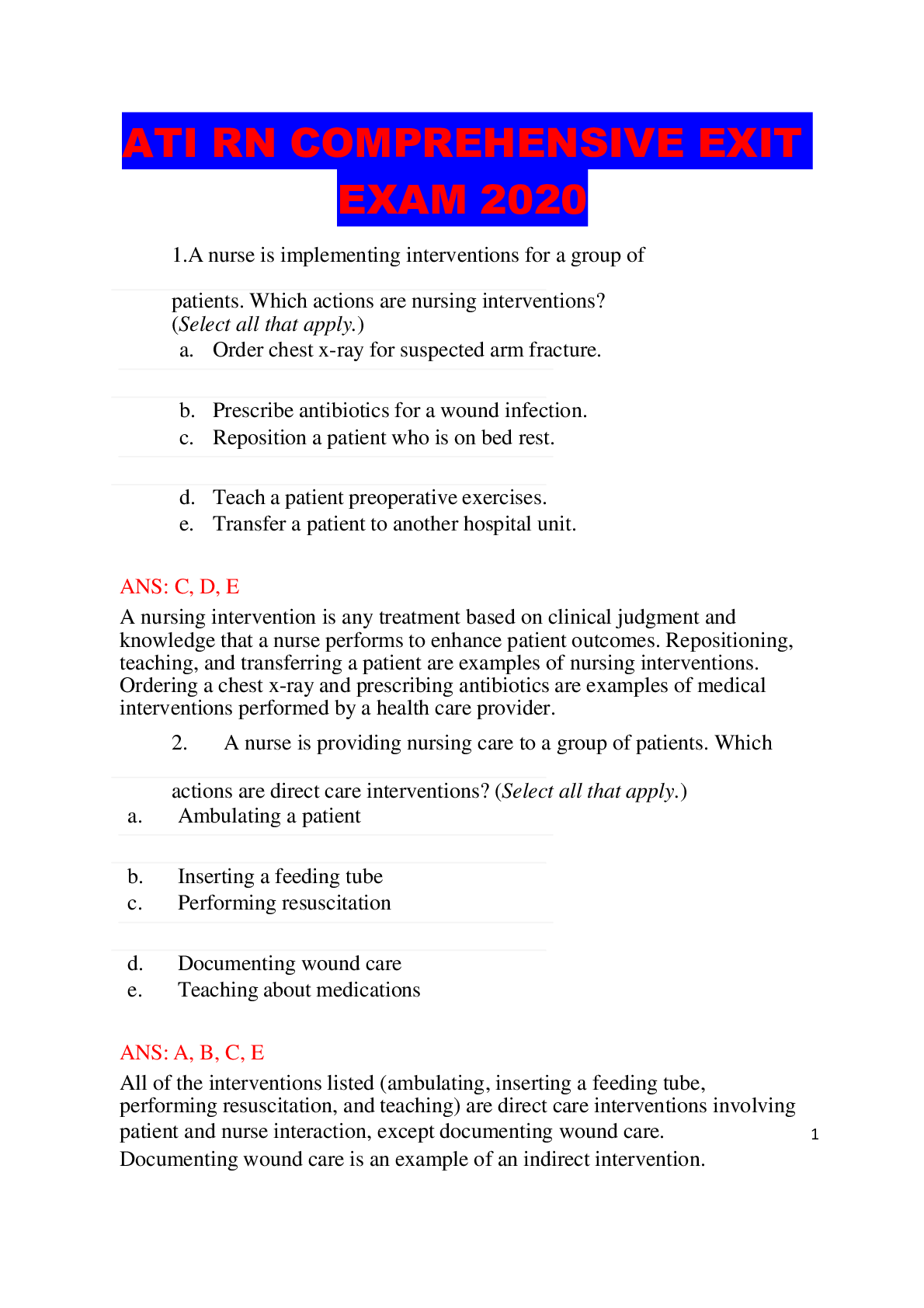

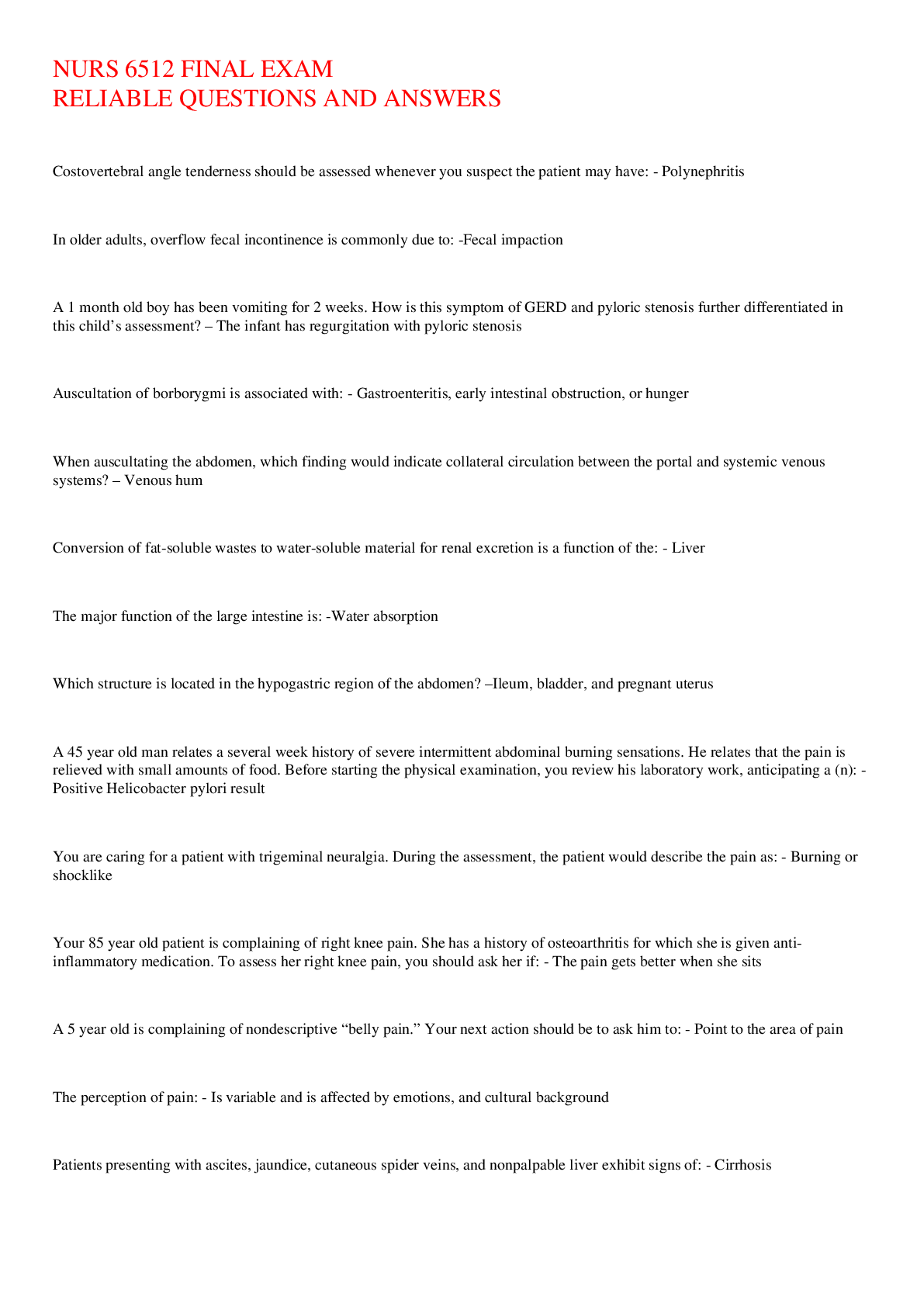
.png)
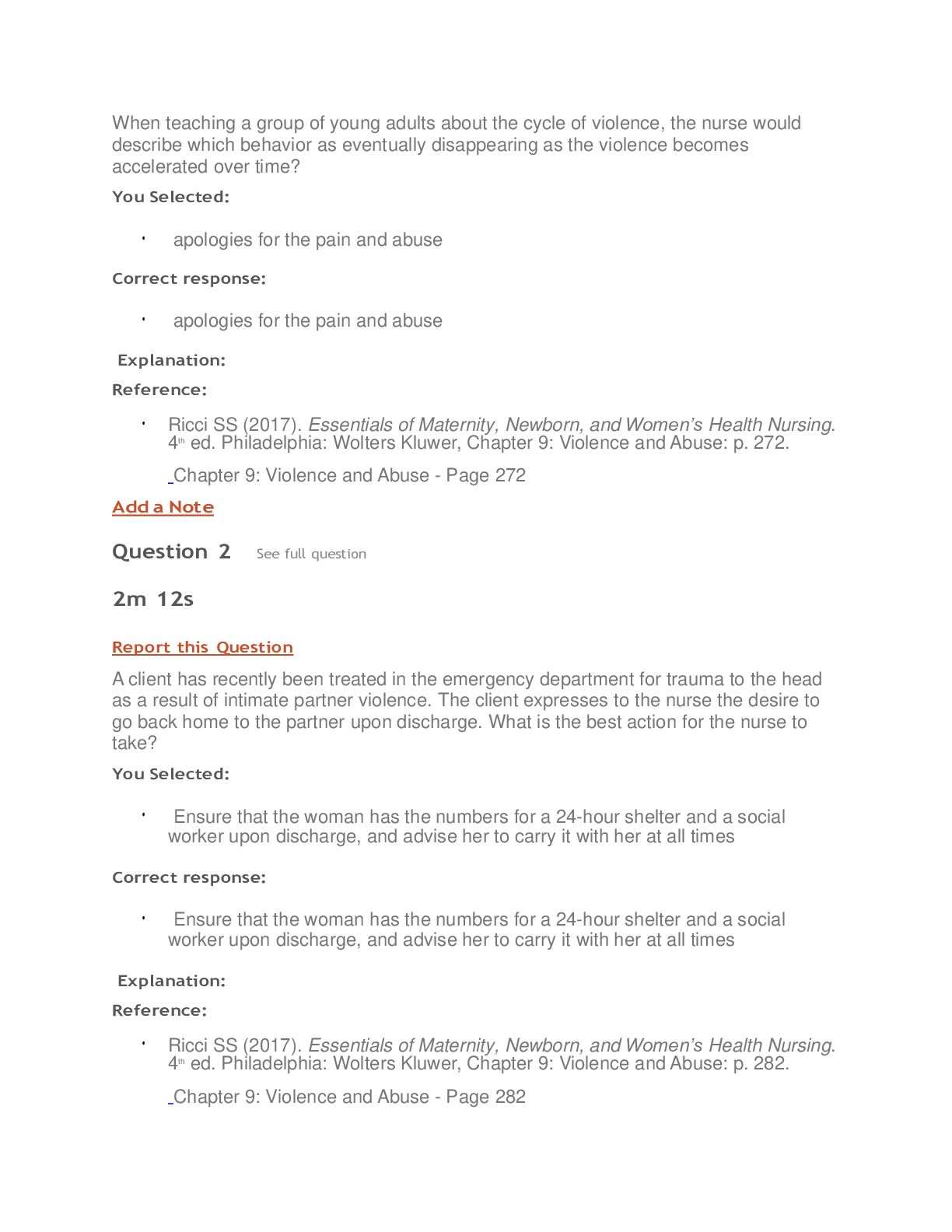

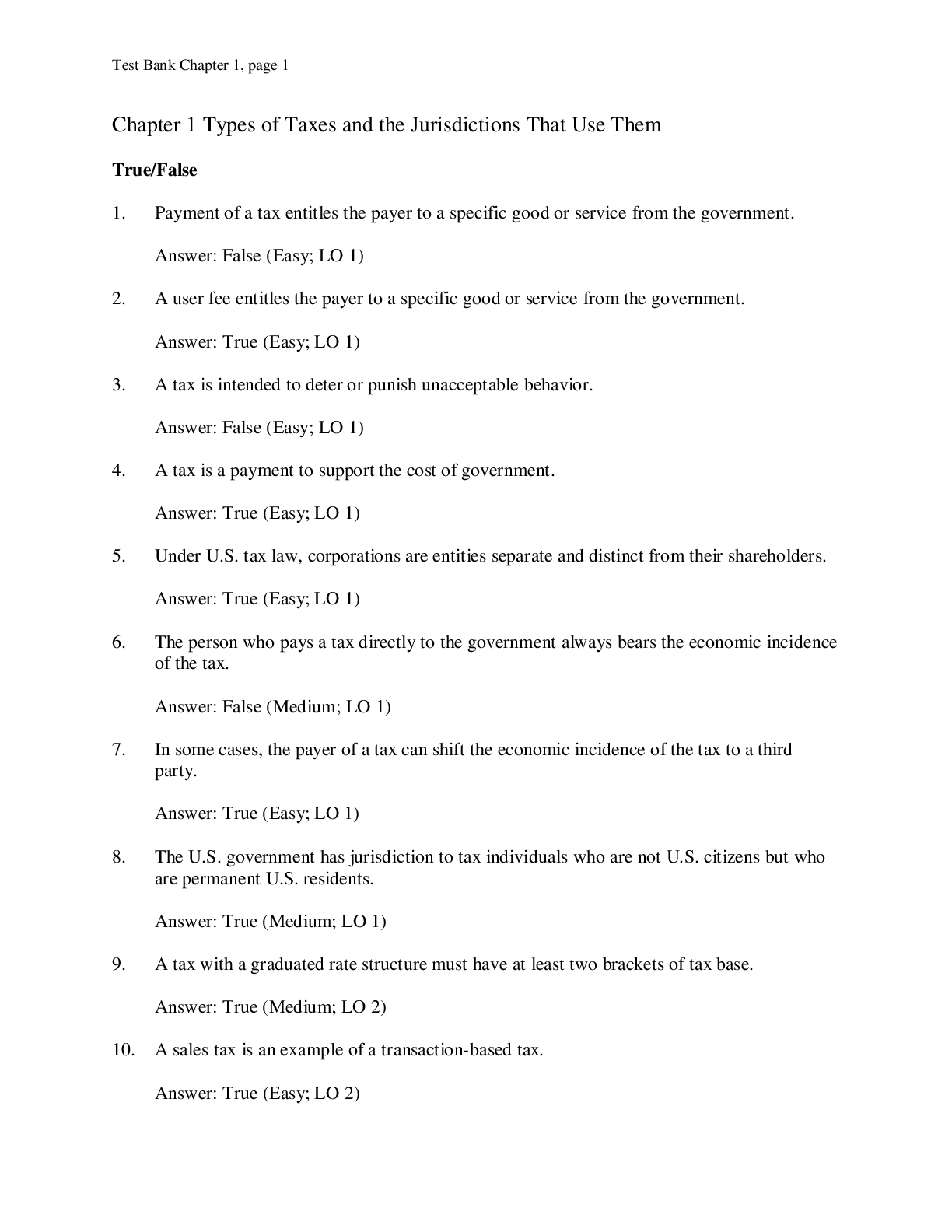
.png)
